Targa Florio
| Category | Endurance |
|---|---|
| Country | Tour of Island of Sicily, Italy |
| Inaugural season | 1906 |
| Folded | 1977 |
| Last Drivers' champion |
|
| Last Constructors' champion |
|
| Official website | www.targa-florio.it |

The Targa Florio was an open road endurance automobile race held in the mountains of Sicily near Palermo. Founded in 1906, it was the oldest sports car racing event, part of the World Sportscar Championship between 1955 and 1973. While the first races consisted of a whole tour of the island, the track length in the race's last decades was limited to the 72 kilometres (45 mi) of the Circuito Piccolo delle Madonie, which was lapped 11 times.
After 1973, it was a national sports car event until it was discontinued in 1977 due to safety concerns. It has since been run as a rallying event, and is part of the Italian Rally Championship.
History
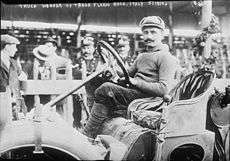

The race was created in 1906 by the wealthy pioneer race driver and automobile enthusiast, Vincenzo Florio, who had started the Coppa Florio race in Brescia, Lombardy in 1900.
One of the toughest competitions in Europe, the first Targa Florio covered 3 laps equalling 277 miles (446 km) through multiple hairpin curves on treacherous mountain roads, at heights where severe changes in climate frequently occurred. Alessandro Cagno won the inaugural 1906 race in nine hours, averaging 30 miles per hour (50 km/h).
By the mid-1920s, the Targa Florio had become one of Europe's most important races, as neither the 24 Hours of Le Mans nor the Mille Miglia had been established yet. Grand Prix races were still isolated events, not a series like today's F1.
The wins of Mercedes (not yet merged with Benz) in the 1920s made a big impression in Germany, especially that of German Christian Werner in 1924, as he was the first non-Italian winner since 1920. Rudolf Caracciola repeated a similar upset win at the Mille Miglia a couple of years later. In 1926, Eliska Junkova, one of the great female drivers in Grand Prix motor racing history, became the first woman to ever compete in the race.
In 1953, the FIA World Sportscar Championship was introduced. The Targa became part of it in 1955, when Mercedes had to win 1-2 with the Mercedes-Benz 300 SLR in order to beat Ferrari for the title. They had missed the first two of the 6 events, Buenos Aires and the 12 Hours of Sebring, where Ferrari, Jaguar, Maserati and Porsche scored. Mercedes appeared at and won in the Mille Miglia, then pulled out of Le Mans as a sign of respect for the victims of the 1955 Le Mans disaster, but won the Tourist Trophy at Dundrod. Stirling Moss/Peter Collins and Juan Manuel Fangio/Karl Kling finished minutes ahead of the best Ferrari and secured the title.
Course variants
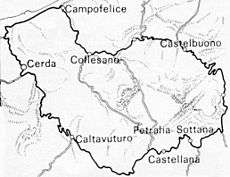
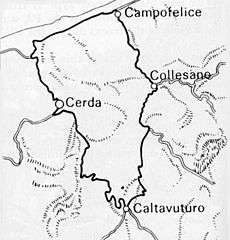
Several versions of the track were used. It started with a single lap of a 148 km (92 mi) circuit from 1906-1911 and 1931. From 1912 to 1914 a tour around the perimeter of Sicily was used, with a single lap of 975 kilometres (606 mi), lengthened to 1,080 kilometres (670 mi) from 1948 to 1950. The 148 km "Grande" circuit was then shortened twice, the first time to 108 km (67 mi), the version used from 1919-1930, and then to the 72 km (45 mi) circuit used from 1932 to 1936 and 1951 to 1977. From 1951-1958, the long coastal island tour variant was used for a separate event called the Giro di Sicilia (Lap of Sicily).
The start and finish took place at Cerda. The counter-clockwise lap lead from Caltavuturo and Collesano from an altitude over 600 metres (1,970 ft) down to sea level, where the cars raced from Campofelice di Roccella on the Buonfornello straight along the coast, a straight over 6 km (3.7 mi) longer than the Mulsanne Straight at the Circuit de la Sarthe in Le Mans. The longest version of the circuit went south through Caltavuturo (whereas the shortest version of the open-road circuit went east just before entry into Caltavuturo, through a mountainous section directly to Collesano) through an extended route through elevation changes, and swept through the nearby towns of Castellana and Sottana, twisting around mountains up to the town of Castelbuono and rejoined the most recent version of the track at Collesano. The second version of the track also went south through Caltavuturo and took a shortcut starting right before Castellana to Collesano via the town of Polizzi Generosa. There was a closed circuit called Favorita Park used from 1937-1940.
The challenge of the Targa was unprecedented in its difficulty and the driving experience of any of the course variants was unlike any other circuit in the world other than perhaps that of the Nurburgring in Germany. The original Grande 148 km (92 mi) circuit had in the realm of 2,000 corners per lap, the 108 km (67 mi) Medio had about 1,300-1,400 corners per lap and the final iteration of the course, the 72 km (45 mi) Piccolo circuit had about 800-900 corners per lap. To put that in perspective, most purpose built circuits have between 12 and 18 corners, and the longest purpose built circuit in the world, the 13-mile Nurburgring, has about 180 corners. So learning any of the Targa Florio courses was extremely difficult and required, like most long circuits, at least 60 laps to learn the course- and unlike the purpose-built Nurburgring, the course had to be learned properly in public traffic, and one lap would take about an hour to do in a road car- if there was little to no traffic.
Lap speeds
Like a rally event (and the Isle of Man TT), the race cars were started one by one every 15 seconds for a time trial, as a start from a full grid was not possible on the tight and twisty roads.
Although the public road circuit used for the Targa was extremely challenging- it was a very different kind of circuit and race from any other race on the sportscar calendar. All of the circuit variations of the Targa had so many corners that lap speeds at the Targa never went higher than 80 mph (128 km/h). Helmut Marko set the lap record in 1972 in an Alfa Romeo 33TT3 at 33 min 41 s at an average of 128.253 km/h (79.693 mph) during an epic charge where he made up 2 minutes on Arturo Merzario and his Ferrari 312PB.[1] The fastest ever was Leo Kinnunen in 1970, lapping in the Porsche 908/3 at 128.571 km/h (79.890 mph) or 33 min 36 seconds flat.[2]
Due to the track's length, drivers practised in the week before the race in public traffic, often with their race cars fitted with license plates. Porsche factory drivers even had to watch onboard videos, a sickening experience for some. The lap record for the 146 km "Grande" circuit was 2 hours 3 min 54.8 seconds set by Achille Varzi in a Bugatti Type 51 at the 1931 race at an average speed of 70.7 km/h (43.931 mph).[3] The lap record for the 108 km "Medio" circuit was 1 hour 21 min 21.6 seconds set by Varzi in an Alfa Romeo P2 at an average speed of 79.642 km/h (49.487 mph) at the 1930 race.[4] The fastest completion around the short version of the island tour was done by Giovanni "Ernesto" Ceirano in a SCAT at the 1914 race, completed in 16 hours, 51 minutes and 31.6 seconds from May 24–25, 1914.[5] The fastest completion of the long version of the island tour was by Mario and Franco Bornigia in an Alfa Romeo 8C 2500, completed in 12 hours, 26 minutes and 33 seconds flat at the 1950 race at an average speed of 86.794 km/h (53.931 mph).[6]
1970s, Safety and demise
In the late 1960s and early 1970s, race cars with up to 600 hp (450 kW) such as Nino Vaccarella's Ferrari 512S raced through small mountain villages while spectators sat or stood right next to, or even on, the road. Porsche, on the other hand, did not race its big Porsche 917, but rather the nimble Porsche 908/03 Spyders.
Due to safety concerns, especially by Helmut Marko, who called the race "totally insane", the last Targa Florio as a World Sportscar Championship race was run in 1973; where during this event it became impossible to retain its international status after a number of horrendous and 2 fatal accidents at the event; one which privateer Charles Blyth crashed his Lancia Fulvia HF into a trailer at the end of the Buonfornello straight and was killed; and another where an Italian driver crashed his Alpine-Renault into a group of spectators, killing one. There were several other accidents during practice for the 1973 event in which a total of seven spectators sustained injuries. In that year, even a Porsche 911 won as the prototypes such as Jacky Ickx's Ferrari suffered crashes or other troubles. Another reason for the Targa's international demise was because international automotive governing body, the FIA, mandated safety walls on all circuits that were going to hold FIA-mandated events; and the 44-mile length of combined public roads made this simply impossible and totally impractical, especially from a financial standpoint. The Targa was continued as a national event for some years, before a crash in 1977 which killed 2 spectators and seriously injured 5 others (including the driver) sealed its fate. The 1977 race was forcibly taken over by local police and was stopped on the 4th lap, and it also saw 2 other drivers having serious accidents; one of them was critically injured, but survived.
Although the Targa Florio was a rally-type race that took place on closed-off Sicilian public mountain roads with (aside from straw bales and weak guardrails at some of the turns, the latter were installed by the island's government) practically no safety features, only 9 people- including spectators- died at the event over the 71 year and 61 race history using a total of 6 circuit configurations. This amount is relatively small compared to other open road races, like the Mille Miglia, where over a period of 30 years and 24 races, 56 people lost their lives and the Carrera Panamericana, where over a period of 5 years and 5 races, 25 people were killed. This is probably due to the fact that the mountain roads were extremely twisty and average speeds never reached even 80 mph even up to the final years of the race's history, even with the very long straight at the northernmost of the track.
Legacy
After winning the race several times, Porsche named the hardtop convertible version of the 911 after the Targa. The name targa means plaque or plate, see targa top.
The Australian-made Leyland P76 had a special version named Targa Florio named to commemorate victory by journalist-rallyist Evan Green on a Special Stage of the 1974 London-Sahara-Munich World Cup Rally which was held on the Targa Florio course.[7]
Since 1992 the event has lent its name to a modern recreation, staged half-a-world away in the form of the famous road rally Targa Tasmania held on the island state of Tasmania, off the Southern coast of Australia. There are also the Targa New Zealand since 1995, and the Targa Newfoundland since 2002.
Winners
 Jean Porporato finishing fourth at the 1908 race with Berliet.
Jean Porporato finishing fourth at the 1908 race with Berliet.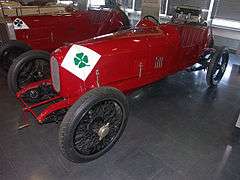 Alfa Romeo RL TF - winner in 1923.
Alfa Romeo RL TF - winner in 1923. Albert Divo at the 1929 Targa Florio with Bugatti Type 35C.
Albert Divo at the 1929 Targa Florio with Bugatti Type 35C. Alfa Romeo 8C winner in 1931, 1932 and 1933.
Alfa Romeo 8C winner in 1931, 1932 and 1933..jpg) Maserati 6CM - winner in 1937-1939
Maserati 6CM - winner in 1937-1939 Ferrari 166MM Barchetta, similar to 1948 winner driven by Clemente Biondetti and Igor Troubetzkoy
Ferrari 166MM Barchetta, similar to 1948 winner driven by Clemente Biondetti and Igor Troubetzkoy Mercedes-Benz 300 SLR similar to the 1955 winner driven by Stirling Moss and Peter Collins
Mercedes-Benz 300 SLR similar to the 1955 winner driven by Stirling Moss and Peter Collins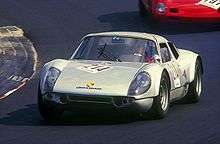
 Targa Florio 1965, Collesano
Targa Florio 1965, Collesano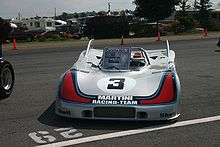 Porsche 908/3 similar to the one driven by Jo Siffert and Brian Redman in 1970
Porsche 908/3 similar to the one driven by Jo Siffert and Brian Redman in 1970 Porsche 911 Carrera RSR driven by Herbert Müller and Gijs van Lennep in 1973
Porsche 911 Carrera RSR driven by Herbert Müller and Gijs van Lennep in 1973 Lancia Stratos Turbo
Lancia Stratos Turbo
| Year | Winner | Car | Time | Distance (km) | Speed (km/h) | Laps | Course Variant |
|---|---|---|---|---|---|---|---|
| 1906 | Itala 35/40 HP | 9:32:22 | 446.469 | 46.80 | 3 | Grande Circuit (146 km) | |
| 1907 | Fiat 28/40 HP | 8:17:36 | 446.469 | 53.83 | 3 | ||
| 1908 | Isotta Fraschini 50 HP | 7:49:26 | 446.469 | 57.06 | 3 | ||
| 1909 | S.P.A. 28/40 HP | 2:43:19 | 148.823 | 54.67 | 1 | ||
| 1910 | Franco Automobili 35/50 HP | 6:20:47 | 297.646 | 46.90 | 2 | ||
| 1911 | SCAT 22/32 HP | 9:32:22 | 446.469 | 46.80 | 3 | ||
| 1912 | SCAT 25/35 HP | 24:37:19 | 979.000 | 41.44 | 1 | Island Tour (short) (979 km) | |
| 1913 | Nazzaro Tipo 2 | 19:18:40 | 979.000 | 50.70 | 1 | ||
| 1914 | SCAT 22/32 | 16:51:31 | 979.000 | 58.07 | 1 | ||
| 1919 | Peugeot EXS | 7:51:01.8 | 432 | 55 | 4 | Media Circuit (108 km) | |
| 1920 | Nazzaro GP | 8:27:23.8 | 432 | 50.924 | 4 | ||
| 1921 | Fiat 451 | 7:25:05.2 | 432 | 58.236 | 4 | ||
| 1922 | Mercedes GP/14 | 6:50:50.2 | 432 | 63.091 | 4 | ||
| 1923 | Alfa Romeo RL Targa Florio | 7:18:00.2 | 432 | 59.177 | 4 | ||
| 1924 | Mercedes Tipo Indy 2,0 | 6:32:37.4 | 432 | 66.010 | 4 | ||
| 1925 | Bugatti T35 | 7:32:27.2 | 540 | 71.609 | 5 | ||
| 1926 | Bugatti T35T | 7:20:45.0 | 540 | 73.507 | 5 | ||
| 1927 | Bugatti T35C | 7:35:55.4 | 540 | 71.065 | 5 | ||
| 1928 | Bugatti T35B | 7:20:56.6 | 540 | 73.478 | 5 | ||
| 1929 | Bugatti T35C | 7:15:41.7 | 540 | 74.366 | 5 | ||
| 1930 | Alfa Romeo P2 | 6:55:16.6 | 540 | 78.010 | 5 | ||
| 1931 | Alfa Romeo 8C-2300 Monza | 9:00:27.0 | 584 | 64.834 | 4 | Grande Circuit (146 km) | |
| 1932 | Alfa Romeo 8C-2300 Monza | 7:15:50.6 | 574 | 79.296 | 8 | Piccolo Circuit (72 km) | |
| 1933 | Alfa Romeo 8C-2300 Monza | 6:35:03.0 | 504 | 76.729 | 7 | ||
| 1934 | Alfa Romeo Tipo-B P3 | 6:14:26.8 | 432 | 69.222 | 6 | ||
| 1935 | Alfa Romeo Tipo-B P3 | 5:27:29.0 | 432 | 80.010 | 6 | ||
| 1936 | Lancia Augusta | 2:08:47.2 | 144 | 67.088 | 2 | ||
| 1937 | Maserati 6CM | 2:55'49.0 | 315.6 | 107.704 | 60 | Favorita Park (5.26 km) | |
| 1938 | Maserati 6CM | 1:30'04.6 | 171.6 | 114.303 | 30 | ||
| 1939 | Maserati 6CM | 1:40.15.4 | 228 | 136.445 | 40 | ||
| 1940 | Maserati 4CL | 1:36.08.6 | 228 | 142.288 | 40 | ||
| 1948 | Ferrari 166 | 12:12'00.0 | 1080 | 88.866 | 1 | Island Tour (long) (1080 km) | |
| 1949 | Ferrari 166 SC | 13:15.09.4 | 1080 | 81.494 | 1 | ||
| 1950 | Alfa Romeo 6C 2500 Competizione | 12:26.33.0 | 1080 | 86.794 | 1 | ||
| 1951 | Frazer Nash | 7:31.04.8 | 576 | 76.631 | 8 | Piccolo Circuit (72 km) | |
| 1952 | Lancia Aurelia B20 | 7:11.58.0 | 576 | 76.631 | 8 | ||
| 1953 | Lancia D20 3000 | 7:08.35.8 | 576 | 80.635 | 8 | ||
| 1954 | Lancia D24 | 6:24.18.0 | 576 | 89.930 | 8 | ||
| 1955 | Mercedes-Benz 300 SLR | 9:43.14.0 | 936 | 96.290 | 13 | Piccolo Circuit (72 km) | |
| 1956 | Porsche 550 | 7:54.52.6 | 720 | 90.770 | 10 | ||
| 1957 | Fiat 600 | - | 359 | - | 5 | ||
| 1958 | Ferrari 250 TR 58 | 10:37.58.1 | 1008 | 94.801 | 14 | ||
| 1959 | Porsche 718 RSK | 11:02.21.8 | 1008 | 91.309 | 14 | ||
| 1960 | Porsche 718 RS 60 | 7:33.08.2 | 720 | 95.320 | 10 | ||
| 1961 | Ferrari Dino 246 SP | 6:57.39.4 | 720 | 103.433 | 10 | ||
| 1962 | Ferrari Dino 246 SP | 7:02'56.3 | 720 | 102.143 | 10 | ||
| 1963 | Porsche 718 GTR | 6:55.45.1 | 720 | 109.908 | 10 | ||
| 1964 | Porsche 904 GTS | 7:10.53.3 | 720 | 100.258 | 10 | ||
| 1965 | Ferrari 275 P2 | 7:01:12.4 | 720 | 102.563 | 10 | ||
| 1966 | Porsche Carrera 6[9] | 7:16:32.6 | 720 | 98.910 | 10 | ||
| 1967 | Porsche 910 [10] | 6:37.01.0 | 720 | 108.812 | 10 | ||
| 1968 | Porsche 907 | 6:28:47.9 | 720 | 111.112 | 10 | ||
| 1969 | Porsche 908/2 | 6:07:45.3 | 720 | 117.469 | 10 | ||
| 1970 | Porsche 908/3[11] | 6:35.30.0 | 792 | 120.152 | 11 | ||
| 1971 | Alfa Romeo 33/3 | 6:35:46.2 | 792 | 120.070 | 11 | ||
| 1972 | Ferrari 312PB | 6:27:48.0 | 792 | 122.537 | 11 | ||
| 1973 | Porsche 911 Carrera RSR [12] | 6:54:20.1 | 792 | 114.691 | 11 | ||
| 1974 | Lancia Stratos [13] | 4:35:02.6 | 576 | 114.883 | 8 | Piccolo Circuit (72 km) | |
| 1975 | Alfa Romeo 33TT12 [14] | 4:59:16.7 | 576 | 120.895 | 8 | ||
| 1976 | Osella PA4-BMW [15] | 5:43:46.0 | 576 | 99.090 | 8 | ||
| 1977 | Chevron B36-BMW [15] | 2:41:17.0 | 288 | 107.140 | 4 |
- "Amphicar"'s actual name was Eugenio Renna.
Races between 1955 and 1973 were part of the World Championship, with the 1957 race not a race but a regularity test, following the Mille Miglia accident.
Wins by make
_in_the_Porsche-Museum.jpg)

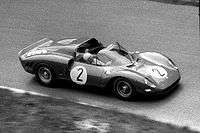
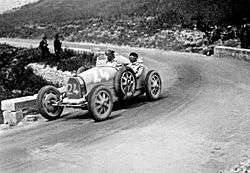
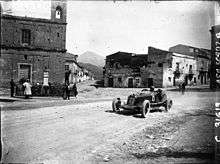
The list below includes all car manufacturers who have attained a podium. The table does not include the results of the 1957 edition, which was held as a regularity race.
| Pos. | Brand | 1st place |
2nd place |
3rd place |
Fastest laps |
|---|---|---|---|---|---|
| 1 | 11 | 9 | 12 | 8 | |
| 2 | 10 | 13 | 7 | 10 | |
| 3 | 7 | 6 | 4 | 7 | |
| 4 | 5 | 7 | 5 | 4 | |
| 5 | 5 | 4 | 5 | 6 | |
| 6 | 4 | 6 | 9 | 4 | |
| 7 | 3 | 2 | 1 | 4 | |
| 8 | 3 | 0 | 0 | 0 | |
| 9 | 2 | 3 | 3 | 2 | |
| 10 | 2 | 0 | 0 | 0 | |
| 11 | 1 | 2 | 1 | 1 | |
| 12 | 1 | 1 | 1 | 2 | |
| 13 | 1 | 1 | 1 | 1 | |
| 14 | 1 | 1 | 0 | 0 | |
| 15 | 1 | 0 | 1 | 1 | |
| 16 | 1 | 0 | 0 | 1 | |
| 17 | 1 | 0 | 0 | 0 | |
| 17 | 1 | 0 | 0 | 0 | |
| 19 | 0 | 1 | 1 | 0 | |
| 19 | 0 | 1 | 1 | 0 | |
| 19 | 0 | 1 | 1 | 0 | |
| 22 | 0 | 1 | 0 | 1 | |
| 23 | 0 | 1 | 0 | 0 | |
| 23 | 0 | 1 | 0 | 0 | |
| 25 | 0 | 0 | 1 | 1 | |
| 26 | 0 | 0 | 1 | 0 | |
| 26 | 0 | 0 | 1 | 0 | |
| 26 | 0 | 0 | 1 | 0 | |
| 26 | 0 | 0 | 1 | 0 | |
| 26 | 0 | 0 | 1 | 0 | |
| 26 | 0 | 0 | 1 | 0 | |
| 32 | 0 | 0 | 0 | 1 |
See also
Further reading
- Clarke, R M, ed. (1999). Targa Florio: The Ferrari & Lancia Years, 1948-1954. Cobham, Surrey, UK: Brooklands Books. ISBN 1855204983.
- Clarke, R M, ed. (1999). Targa Florio: The Porsche & Ferrari Years, 1955-1964. Cobham, Surrey, UK: Brooklands Books. ISBN 1855204878.
- Clarke, R M, ed. (1999). Targa Florio: The Porsche Years, 1965-1973. Cobham, Surrey, UK: Brooklands Books. ISBN 1855204886.
- Valenza, Giuseppe (2007). Targa Florio Il Mito: Legenda Editore (Italy). ISBN 9788888165172.
References
- ↑ "56th Targa Florio 1972". formula2.net. Retrieved 2008-07-13.
- ↑ "Leo Kinnunen". forix.autosport.com. Retrieved 2008-07-13.
- ↑ "Targa Florio 1931". Formula2.net. 2001-08-26. Retrieved 2011-10-18.
- ↑ "Targa Florio 1930". Formula2.net. Retrieved 2011-10-18.
- ↑ "1914 Targa Florio - The AUTOSPORT Bulletin Board". Forums.autosport.com. Retrieved 2011-10-18.
- ↑ "Targa Florio 1950". Formula2.net. Retrieved 2011-10-18.
- ↑ "The Leyland P76 a brief history". Themotorreport.com.au. 2008-06-09. Retrieved 2011-05-12.
- ↑ "F2 Register - Index". Formula2.net. Retrieved 2011-10-18.
- ↑ "Race report". Imca-slotracing.com. Retrieved 2011-05-12.
- ↑ "Race report". Imca-slotracing.com. Retrieved 2011-05-12.
- ↑ Race report 54th TARGA FLORIO
- ↑ Race report TARGA FLORIO (ROUND #6)
- ↑ "World Sports Racing Prototypes - Non Championship Races 1974". Wsrp.ic.cz. Retrieved 2013-01-05.
- ↑ "World Sports Racing Prototypes - Non Championship Races 1975". Wsrp.ic.cz. Retrieved 2013-01-05.
- 1 2 "World Sports Racing Prototypes - Non Championship Races 1976". Wsrp.ic.cz. Retrieved 2013-01-05.
External links
| Wikimedia Commons has media related to Targa Florio. |
- Targa Florio official website
- Museo Targa Florio Collesano
- Targa Florio History
- Targappassionati
- Porsche at Targa Florio
- Targa Florio memorabilia
- Museo Biblioteca Vincenzo Florio a Campofelice di Roccella - www.targaflorio-1906-1977.it
- http://www.targapedia.com
- The full Targa Florio for GrandPrix Legends
- http://www.amicidellatargaflorio.com
- Le Auto. Targa Florio, 1906 1977, Gallery of winners.
- Sport-auto. Gallery of competitors 1906-1977
- a sicilian dream
- History of the Targa Florio
Coordinates: 37°56′52″N 13°47′10″E / 37.94778°N 13.78611°E